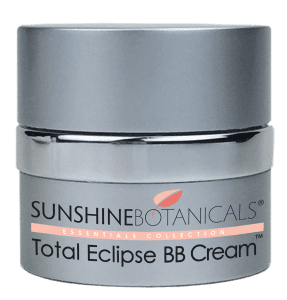

Hyperpigmentation
These conditions are rooted in an abnormal increase in melanin production, the pigment that darkens the skin. Those who already have more melanin in their skin are more likely to develop hyperpigmentation after an inflammatory skin issue. It’s also more likely to stick around for an extended period of time. Blacks, Hispanics, Asians, Pacific Islanders, or Native American heritage are more likely to see these concerns and often reach for bleaching creams to correct.
Dermatologists typically recommend the short-term use of Hydroquinone [1]— an over-the-counter or prescription cream with a max dose of 2% that is FDA approved but still happens to be a bit controversial. Usually, a serious allergic reaction to the Hydroquinone is rare, though users may sometimes experience mild redness, dryness, or itching of the affected area. However, according to Dr. Andrea Kassim, a board-certified dermatologist in Morristown, NJ, “there is evidence to suggest that certain skin-whitening medicines like Hydroquinone contain ingredients which may be carcinogenic that can be harmful.[2] In other words, the drug may increase risks of cancer”. For that reason, though available over the counter in low doses in the United States, Hydroquinone can only be obtained by prescription from a doctor in many countries. It was even banned for a while in Europe but is now once again attainable by prescription only.
Overuse of skin whiteners can also cause pigmentation to build up in your extremities (fingers, toes, ears, etc.), causing them to look darker and mismatched. Another adverse reaction can develop, known as the “bleached panda effect,” where the skin on the face becomes thinner around the eyes and has increased pigmentation. Cute on a panda, not so much on a human.
As more information is coming forward regarding the toxicity and side-effects of so many topical medications, it is incredibly comforting to know that nature provides many impressive solutions for so many of these frustrating skin conditions. “There are many naturally occurring agents found in nature that have lightening properties,” Dr. Kassim explained. Chemical-free alternatives to over-the-counter or prescription skin lightening products are easily spotted over-the-counter. These products include Vitamin C (essential for its skin brightening and antioxidant effects). In the AHA family, malic and tartaric acids are excellent skin brighteners without causing inflammation or irritation. Chemical-free skin peels and resurfacing alternatives to caustic, chemical peels include enzymes extracted from fresh pumpkins. This enzyme is an excellent skin peel formulation containing high levels of beta carotene (vitamin A) known for its skin lightening and anti-aging benefits and gently resurfaces and smooths blotchy, discolored skin and my do the trick!
What is Dermatosis Papulosa Nigra?

Dermatosis Papulosa Nigra (DPN),
Veteran actor Morgan Freeman has a skin condition that affects almost 30 % of the dark-skinned population in the United States. Medically known as Dermatosis Papulosa Nigra (DPN), this skin condition looks like little black bumps on the face and neck.
The cause of DPN is still unknown. It is believed to be a congenital anomaly of the skin caused by a hair follicle’s developmental defect. Some medical professionals speculate that it is due to photoaging, while other researchers believe it is a combination of sun exposure and heredity. Around 50% of patients seeking treatment have a family history of the skin condition—a parent or grandparent, for example, might have them. These typically begin during the teen years, and they may increase in number and size as a person ages.
DPN doesn’t require medical treatment – it actually is considered more of a cosmetic concern than anything. While these are benign growths, if you are not sure that a lesion that has developed is dermatosis papulosa nigra, you should check with a dermatologist to make sure it isn’t a serious or cancerous growth.
Once this is ruled out, some very effective, simple treatments are available to get rid of these pesky little skin growths… Two methods use electric current to destroy and remove DPN: electrocautery and electrodesiccation. With electrocautery (or thermal cautery), electric current runs through a small probe with a fine needle electrode tip to cauterize (burn or destroy) skin tissue. In electrocautery, the tip becomes hot, but the current doesn’t pass through the patient.
Electrodesiccation is a specific type of electrosurgery (also called fulguration) and dehydrates and destroys superficial tissue. The electrode remains cool, and the electrical current passes through the tissue. Without touching the surrounding skin, the lesions are desiccated using an instrument with an electrical needle-like tip until the lesions turn a grayish color. An application of a topical anesthetic prior to the procedure will make it more comfortable. At low settings, these are considered safe and effective procedures with minimal to no scarring. I do this treatment in my skincare clinic a lot and highly recommend electrodesiccation treatments for this condition. The best ingredients to use on the skin to support healing the skin after treatment and help prevent scarring and discoloration include serums and balms containing comfrey, calendula, aloe, essential fatty acids, and colloidal silver are very healing post-procedure and will minimize discoloration from these treatments.

Dry, Ashy Skin
If your skin is prone to being dry, you might notice some white or chalky flakes on your legs or arms. Next thing you know, you are scratching your skin, and it looks like a tic-tac-toe board from all the scratch marks! Yep – that’s ashy skin!
Ashy skin is caused by the dryness of the skin and the retention of dead skin cells on the skin’s surface. When skin cleansing and regular exfoliation doesn’t happen, these dead surface layers build up; think of roofing shingles on a house… they overlap each other and continue to build up, one on top of the other. This dead skin build-up makes it almost impossible for moisturizing body products to absorb or get into the skin. The result of this build-up and accumulation of dead skin cells is white in appearance – thus, ashy skin.
Preventing and Treating Ashy Skin
- Cleanse your skin gently: in winter, skin not only has to deal with the cold air outside but heating in the car, at home and the office, etc. For sensitive skin, eczema, and problem skin: Redness Relief Bar is excellent to fight bacteria, fungus, and yeast on the face and body. Cleanse and Clear is a very effective texture refining cleanser of oily and acne skin and razor bumps for men and women. This fresh, exfoliating cleanser also minimizes skin discoloration with enzymes and malic and tartaric acids that will not irritate the skin.
- Stay away: from deodorant soaps and skincare products with alcohol, fragrance, retinoids, or harsh acids.
- Moisturize: while moisturizing seems like an absolute no-brainer, retaining moisture throughout the day can be challenging, especially in frigid, dry weather. It is vital to understand that the key to your skin’s ability to absorb and retain a healthy posture starts with cleansing and detoxification! Eliminating the build-up of oils, waste, and daily grime waste that plugs the pores is
THE most important step to bring clarity and balance to the skin. For deep moisture from head to toe, hydrate and moisturize your skin right after bathing or shower for maximum absorption.
If ashy skin persists after following these steps, there are some more potent remedies. If there is a particularly ashy area, you can use Cleanse and Clear applied full strength directly to dry skin BEFORE lathering this skin brightening cleanser into the face or affected areas for at least 60 seconds, then rinse very well. This cleanser is very keratolytic – this simply means that it helps the skin’s dead surface layers dissolve and shed quickly to reduce the skin’s ashy appearance.
Always wear Sunblock

Although people with black skin are less likely to get skin cancer from sun exposure, they are more likely to die from the condition if it does develop. Ethnic skin may be more difficult to notice and diagnose. Sun exposure can also cause dark spots, such as those typical of melasma, to develop on black skin. It can also make existing spots darker.
Regardless of skin tone or season, I recommend applying a sunblock whenever you going to be outside, even on cloudy days.
Rashes and Eczema on Skin of Color
The appearance of a rash varies with skin tone. On the skin of color, a rash may be purple, gray, or white —some redness may appear, but typically not very much.
The rash tone variation is due to melanin, a molecule that gives the skin and hair their color. Generally, the more melanin a person has in their skin, the darker their skin tone. It affects how the skin reacts to sunlight, damage, and health conditions that cause rashes.
The skin condition of eczema is a group of conditions that make the skin dry, itchy, and inflamed. It is common and can appear anywhere on the body and looks different on Caucasian skin, typically red, scaly, and inflamed.
Shaving, Waxing, and Razor Bumps

Pseudofolliculitis Barbae
Folliculitis and Pseudo-Folliculitis Barbae is the medical terminology used to describe the razor bumps that can affect anyone in all areas of the body where the hair is shaved, plucked, or waxed. This condition occurs when the body has an adverse, inflammatory response to shaving, usually due to folliculitis (ingrown hairs). It is prevalent among African American males.
Most Folliculitis cases (ingrown hairs) and Pseudo-Folliculitis Barbae (razor bump) are due to damaging hair removal products or techniques. Making changes to your grooming practices, such as switching from shaving with razors to trimming the hair with clippers, will help ensure you avoid this condition or improve it.

For severe cases or those that don’t clear up with the clean, daily skincare routine, TCA skin peels, microneedling, and LED Light Therapy are the “go-to” treatments for this often chronic condition.
My Passion is Your Solution
[1] https://www.medicaljournals.se/acta/content/html/10.2340/00015555-1225
[2]https://www.beskinformed.com/skin-whitening/how-to-turn-dark-brown-skin-into-a-lighter-brown-tone/

